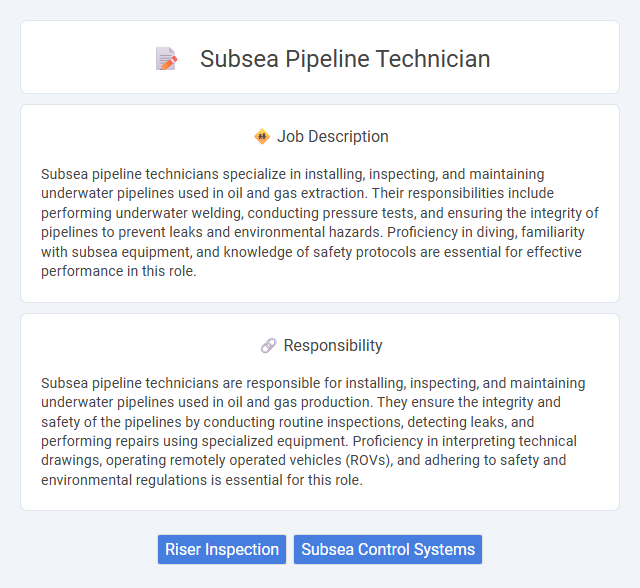
Subsea pipeline technicians specialize in installing, inspecting, and maintaining underwater pipelines used in oil and gas extraction. Their responsibilities include performing underwater welding, conducting pressure tests, and ensuring the integrity of pipelines to prevent leaks and environmental hazards. Proficiency in diving, familiarity with subsea equipment, and knowledge of safety protocols are essential for effective performance in this role.
People with strong physical stamina and excellent problem-solving skills are likely suitable for a subsea pipeline technician job due to the demanding underwater conditions and technical challenges. Individuals comfortable working in confined spaces and underwater environments may have a higher probability of adapting well to this role. Those who may struggle with physical endurance or have a fear of underwater work might find the job less suitable.
Qualification
A Subsea Pipeline Technician requires specialized qualifications including certifications in underwater welding, diving, and pipeline inspection techniques. Proficiency in the use of remotely operated vehicles (ROVs) and knowledge of offshore safety standards such as OSHA and IMCA are essential. Technical training in mechanical engineering or marine technology enhances the ability to perform maintenance, repair, and installation of subsea pipeline systems efficiently.
Responsibility
Subsea pipeline technicians are responsible for installing, inspecting, and maintaining underwater pipelines used in oil and gas production. They ensure the integrity and safety of the pipelines by conducting routine inspections, detecting leaks, and performing repairs using specialized equipment. Proficiency in interpreting technical drawings, operating remotely operated vehicles (ROVs), and adhering to safety and environmental regulations is essential for this role.
Benefit
Subsea pipeline technicians likely benefit from competitive salaries due to the specialized nature of their work in offshore environments. Employment in this field may offer opportunities for extensive travel and work on advanced underwater infrastructure, enhancing professional skills. The role probably includes strong safety protocols and potential for career advancement within the expanding energy sector.
Challenge
The role of a subsea pipeline technician likely involves navigating complex underwater environments, which can pose significant technical and safety challenges. Operators probably encounter unpredictable weather conditions and intricate systems that demand precise installation and maintenance skills. Mastery of advanced tools and adherence to strict safety protocols might be critical to successfully managing these difficulties.
Career Advancement
Subsea pipeline technicians gain expertise in installing, inspecting, and maintaining underwater pipelines critical to the oil and gas industry, which enhances their value in offshore operations. Advanced skills in subsea welding, robotics, and pipeline integrity assessment often lead to supervisory or project management roles. Continuous training and certifications in diving, safety standards, and new technology accelerate career progression within subsea engineering and offshore asset management sectors.
Key Terms
Riser Inspection
Subsea pipeline technicians specializing in riser inspection use advanced non-destructive testing methods to assess the structural integrity of risers connecting subsea pipelines to surface facilities. They employ tools such as ultrasonic testing, magnetic flux leakage, and remotely operated vehicles (ROVs) equipped with high-resolution cameras to detect corrosion, cracks, and weld defects. Ensuring the reliability of risers is critical for preventing leaks and maintaining safety in offshore oil and gas production.
Subsea Control Systems
Subsea pipeline technicians specializing in Subsea Control Systems are responsible for installing, maintaining, and troubleshooting control equipment critical to offshore oil and gas extraction. Their expertise includes working with hydraulic and electrical control modules, umbilicals, and subsea valves to ensure reliable operation under extreme underwater conditions. Proficiency in diagnostic tools, system calibration, and safety protocols is essential for optimizing subsea production and preventing environmental hazards.
 kuljobs.com
kuljobs.com